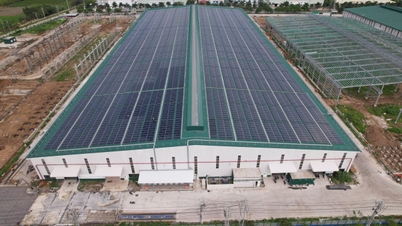NDO - In the context of a sharp decline in the overall birth rate nationwide, especially in urban areas, the policy of "not disciplining Party members who have a third child or more" is a very urgent need.
The policy is correct, appropriate, and based on practical experience.
The Central Party Office has just issued a document announcing the Politburo 's opinion on the preliminary review of the implementation of Resolution 21/2017 of the Central Committee of the Party (12th term) on population work in the new situation and the amendment of Party and State regulations related to population policy.
In a notice from the Central Party Office, the Politburo assigned the Central Inspection Commission to advise on and amend the regulations of the Central Committee, the Politburo, and the Secretariat related to handling violations of population policy, and to proactively amend Guidance No. 05/2022 of the Central Inspection Commission to avoid disciplinary action for cases of having a third child or more, in line with the amendment of legal regulations (without retroactive application to cases already subject to disciplinary action).
The Politburo has assigned the Party Committee of the National Assembly and the Party Committee of the Government to coordinate in leading and directing the acceleration of the drafting and submission of the Population Law to the National Assembly for approval in accordance with the spirit of the 13th Party Congress Resolution in 2025. In the immediate future, the Politburo requests an urgent review and amendment of legal documents containing regulations on the number of children, to be completed in the first quarter of 2025.
According to Professor Nguyen Dinh Cu, former Director of the Institute of Population and Social Issues (National Economics University, Hanoi), this is a very urgent, necessary, and correct policy.
According to Professor Cử, the country currently has over 5.6 million party members. The regulation stipulating "no disciplinary action will be taken against party members who have a third child or more" not only affects this group but has a broader impact on the entire nation.
Speaking with a reporter from Nhan Dan Newspaper, Professor Nguyen Dinh Cu stated that the proposal to relax population policies to maintain replacement fertility levels has been suggested by experts for many years. Therefore, the policy of "not disciplining Party members who have a third child or more" is a correct and appropriate policy, based on domestic practical experience and international experience. Furthermore, the Politburo has requested the acceleration of the drafting of the Population Law; and the urgent review and amendment of legal documents regulating the number of children.
Of particular encouragement is the Politburo's agreement to develop a National Target Program on Population and Development for the period 2026-2035.
According to Matt Jackson, UNFPA Representative, many countries around the world, including Vietnam, are currently witnessing a trend of declining birth rates. A recent UNFPA report indicates that two-thirds of the world's population now lives in countries with birth rates below replacement level. This is not a temporary phenomenon but a new reality for an increasing number of countries.
Replacement fertility rates have fallen to their lowest level in history.
According to Mr. Le Thanh Dung, Director of the Population Department, for three consecutive years, the national birth rate has fallen below the replacement level (2.1 children per woman). According to the results of the mid-term population and housing survey recently published by the General Statistics Office, the Vietnamese birth rate in 2024 will be 1.91 children per woman, the lowest level recorded in history. This is the lowest decline in history, and the trend is projected to continue to decrease in the future.
According to the General Statistics Office, in 2024, Vietnam's total fertility rate was lower than the average of Southeast Asian countries (2 children per woman). Vietnam's fertility rate was only higher than four countries in the region: Brunei (1.8 children per woman), Malaysia (1.6 children), Thailand, and Singapore (1 child per woman).
According to the 2024 survey results, the fertility rate in urban areas is 1.67 children per woman, lower than in rural areas (2.08 children). In rural areas, prior to 2022, the fertility rate was always higher than the replacement level, but in the last two years, the fertility rate has started to decline sharply and is now slightly below the replacement level.
The number of localities with fertility rates below replacement level is trending upwards. Specifically, there were 22 provinces in 2019, 27 provinces in 2023, and this number is expected to reach 32 provinces in 2024. In 2022, Vietnam's total fertility rate reached 2.01 children per woman, decreasing to 1.96 children per woman in 2023 and further declining to 1.91 children per woman in 2024.
There are significant differences in fertility rates among socio-economic regions across the country. The Northern Midlands and Mountains and the Central Highlands have high fertility rates, exceeding the replacement level (2.34 children/woman and 2.24 children/woman, respectively). The two regions with low fertility rates, below the replacement level, are the Southeast and the Mekong Delta (1.48 children/woman and 1.62 children/woman, respectively).
According to the 2021 population survey, there is a growing trend of Vietnamese men and women not wanting to marry, a more common pattern of late childbirth, and disparities in birth rates between different regions...
 |
According to Mr. Le Thanh Dung, Director of the Population Department, for three consecutive years, the national birth rate has fallen below the replacement level (2.1 children per woman). |
Director Le Thanh Dung emphasized that if the birth rate remains low and persists, it will have a direct and profound impact on the population size and structure, leaving many consequences such as labor shortages, rapid population aging, and population decline… significantly affecting the sustainable development of the country.
In the population forecast for Vietnam up to 2069, under the low birth rate scenario, Vietnam will face the risk of a negative average population growth rate (-0.04%) in 2059. Meanwhile, under the medium birth rate scenario, this number would only reach zero 10 years later (2069).
A comprehensive set of policies is needed to increase replacement fertility rates.
Professor Cử emphasized that "not disciplining party members who have a third child or more" is only a change in policy, a necessary condition, but not sufficient to raise the birth rate and ensure "maintaining the replacement birth rate".
According to Professor Nguyen Dinh Cu, in order to have a policy sufficient to ensure the maintenance of replacement fertility levels, Vietnam needs additional solutions.
First, there must be policies to encourage and support families in having and raising young children (diversifying forms of economic support such as subsidies, personal income tax exemptions and reductions, exemptions and reductions of contributions to community funds, etc.).
Raising and educating children is not only a family right but also a community and state right. Therefore, the state and community need to share the responsibility and costs of caring for and raising children from the time they are in the womb. "Many localities have good policies such as waiving tuition fees from preschool to high school – this is a reasonable and correct policy both in terms of morality and reason," Professor Cu said.
Secondly, we need to develop better and higher-quality service facilities for families with young children, such as nurseries and kindergartens, so that parents can feel secure sending their children there. Services providing ready-made meals and domestic help should also be developed to reduce the time spent on housework and lessen the burden on women in caring for their children.
Thirdly, flexible working hours are needed for pregnant women and couples with young children, allowing parents flexible work schedules and time to care for their children. Childcare facilities should offer flexible pick-up and drop-off times.
Fourth, our country has over one million infertile couples. Therefore, the government should not only invest in assisted reproductive technology but also provide financial support and reduce or waive the costs of infertility treatment so that young couples have the right to become parents.
"We need a combination of measures, from economic support and housing to service infrastructure, to raise and maintain the replacement fertility rate. A single policy of 'not disciplining party members who have a third child or more' won't bring about immediate change," Professor Cử emphasized.
According to information from the Ministry of Health, the Population Department has completed the proposal for the Population Law to report to the Government; it is currently focusing on perfecting the institutional framework, specifically completing the draft law to submit to the National Assembly at its 10th session (2025) in order to put Resolution No. 21-NQ/TW into practice.
The Population Law drafted by the Ministry of Health is designed to eliminate the prescribed number of children per couple, instead empowering individuals and couples to make their own decisions and assume their responsibilities. This is considered a fundamental change in the Population Law compared to the previous Population Ordinance.
Source: https://nhandan.vn/khong-xu-ly-ky-luat-dang-vien-sinh-con-thu-ba-tro-len-la-chu-truong-cap-thiet-post861114.html






































































































Comment (0)